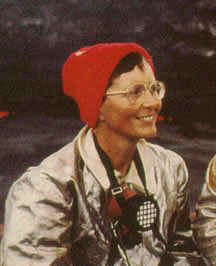Katia Kraft belongs to a group of women who consecrated their lives to working in one of the many predominantly masculine scientific areas: geology. Among them, Etherldred Bennett stands out. She was an expert on fossils, admitted as a member in the Imperial Society of Naturalists of Moscow in 1836 because they thought, given her foreign name, that she was an "Englishman expert in fossils". When they found out that she was actually a woman, it almost caused an international conflict. Another relevant geologist was Dorothea Bate. She travelled by herself to far-away destinations and, whenever she needed help, she hired local men as guides and interpreters. She explored the mountains of Crete, Cyprus and the Balearic Islands between 1901 and 1911, and found pygmy elephants and hippopotami fossils in the two formers, and in the latter, Myotragus balearis. Lastly, María Gordón explained how the southern mountains of Tyrol, in the Alps, had been formed. All of them were pioneers in their field. Thanks to their work, we have a better understanding of planet Earth.

Catherine Joséphine Conrad
(Katia Krafft)
Alsacia, 1942 — Monte Unzen (Japón), 1991
Periodo de actividad: 1969 — 1991
Clasificación geográfica: Europa > Francia
Movimientos socio-culturales
Grupos por ámbito de dedicación
Científicas > Geólogas / Geofísicas > Vulcanólogas
Tecnólogas > Inventoras
Contexto de creación femenina
Reseña
Graduated in Physics and Geochemistry, her first work on vulcanology in active sites was awarded by Vocation Foundation in 1969.
Later on, her career as a volcano researcher brought her to travel the world in the search for dangerous volcanic eruptions that she would study and document systematically during the 1970s and 1980s. It was because of this labour that she and her husband, who always travelled along her in her trips, received the Liotard for Exploration award in 1975.
After their tragic death, they were given many tributes and their photograph and video collection was distributed between the National Museum of Natural History in Paris and the association Images et Volcans.
Actividades
Justificaciones
Biografía
Katia was an adventurous woman passionate about vulcanology. She was born in Alsace in 1942 and she showed, from a very young age, a great interest for volcanos. She even visited some with her parents, like Mount Etna or the Stromboli. She went on to study at University of Strasbourg and graduated in Physics and Geochemistry. Her first work as a vulcanologist in active sites won her the award given by the Foundation Marcel Bleustein-Blanchte pour la vocation in 1969, a fact that distinguished her as a young promise in vulcanology.
In college, she met Maurice, her future husband and work partner. They both dedicated their lives to documenting dangerous volcanic eruptions around the world. Although they were initially considered to be extravagant, their reports awoke people's interest over time. In fact, even if their gas and rock samples contributed to better understanding these geological phenomena, it was their educational work that made them famous. It is worth mentioning their informative campaigns on volcanic risk, since one of their documentaries helped make the Philippine authorities understand the need for evacuating the population due to the imminent eruption of Mount Pinatubo in 1991, a fact that saved countless human lives.
Unfortunately, they both died in June of that same year while documenting the eruption of Mount Unzen, one of the most dangerous volcanos in Japan. The cause of death was a burning cloud of gas, rocks, and ashes that they were not able to predict and reached them unexpectedly fast.
Obras
Bibliografía
- Martínez Cantó, Raquel, Valugo, Aída (2019) “Katia Krafft, la científica que desafiaba a los volcanes”. Principia Cristina Escandón Velasco, Javier Díaz-Romeral Torralbo) and Enrique Royuela Casamayor eds, 30/01/2022 <https://principia.io/2019/07/29/katia-krafft-la-cientifica-que-desafiaba-los-volcanes.Ijk5NSI/>
- Ruix Constan Ana, Nivola Uyá (2019), “Katia Krafft Vida (y muerte) al borde del volcán”. Comisión mujeres y Gegología. Geocharlas. SGE, 30/01/2022, <https://mujeresygeologia.wixsite.com/mujeresygeologia/katiakrafft>
- Wikipedia, 30/01/2022 <https://en.wikipedia.org/wiki/Katia_and_Maurice_Krafft#Katia>
Enfoque Didáctico
Biology-geology in 1st of ESO. It could also be useful in biology-geology in 4th of ESO.